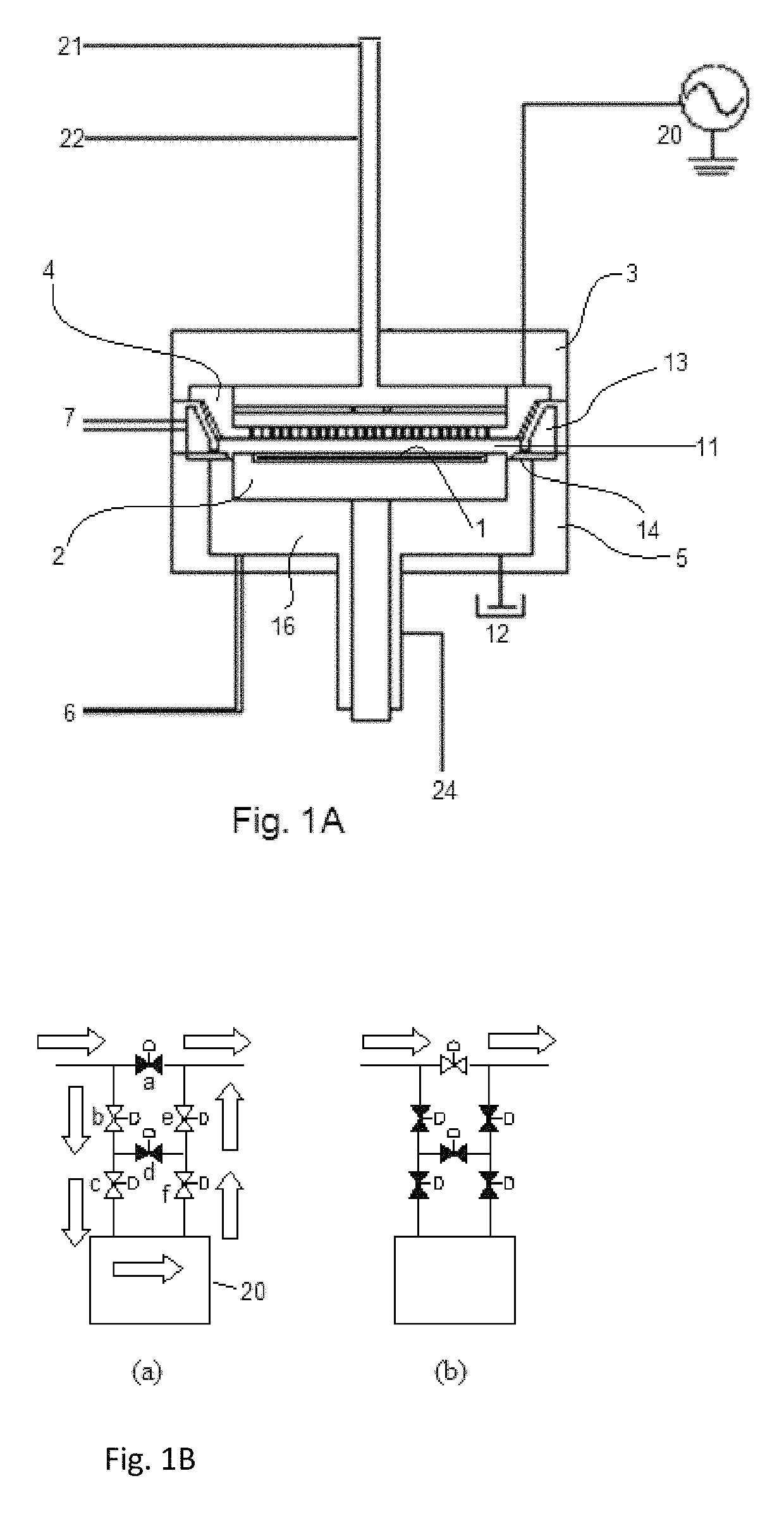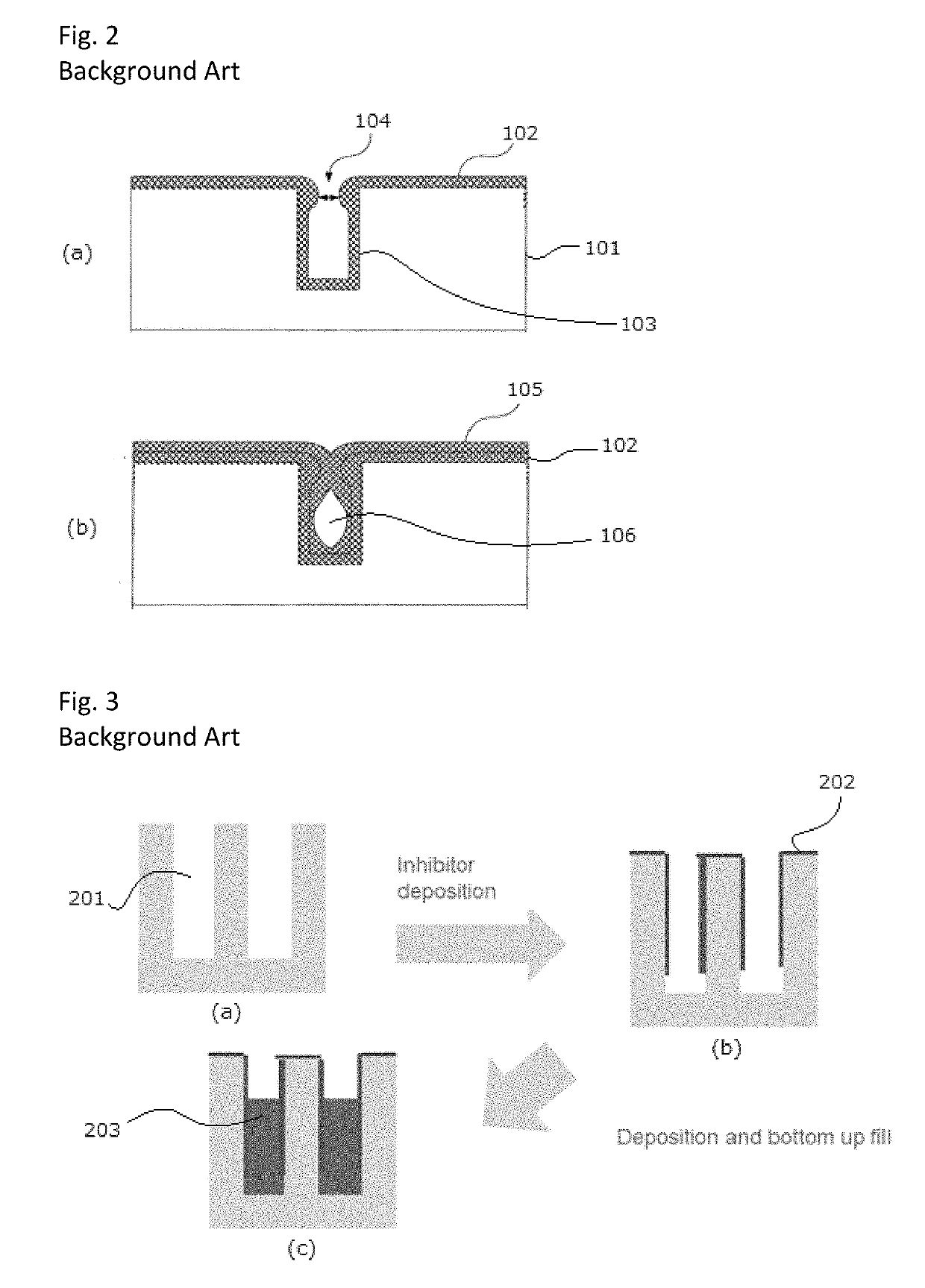Method for depositing silicon-free carbon-containing film as gap-fill layer by pulse plasma-assisted deposition
a technology of silicon-free carbon-containing film and gap-fill layer, which is applied in the direction of coating, chemical vapor deposition coating, metallic material coating process, etc., can solve the problems of difficult to find suitable combinations of inhibitors and activators, increasing difficulty in void-free filling of high aspect ratio spaces (e.g., ar3), and inapplicability
- Summary
- Abstract
- Description
- Claims
- Application Information
AI Technical Summary
Benefits of technology
Problems solved by technology
Method used
Image
Examples
example 1
[0086]A Si-free C-containing film was deposited on a Si substrate (having a diameter of 300 mm and a thickness of 0.7 mm) having narrow / deep trenches with an opening of approximately 20 nm, which had a depth of approximately 200 nm (an aspect ratio was approximately 10), and narrow / shallow trenches with an opening of approximately 20 to 35 nm, which had a depth of approximately 90 nm, by PEALD-like process in order to determine filling capability of the film, under the conditions shown in Table 5 below using the apparatus illustrated in FIG. 1A and a gas supply system (FPS) illustrated in FIG. 1B. A carrier gas (its flow rate was 0.1 slm) was used to feed the precursor to the reaction chamber. However, the carrier gas is not required because of the high vapor pressure of the precursor. In this example, small mass flow of the carrier was used just as a precaution against precursor condensation in the line. If the line is sufficiently heated, no carrier gas need be used. Further, alth...
example 2
[0091]A Si-free C-containing film was deposited on a Si substrate in a manner substantially similar to that in Example 1, and the properties of the film was evaluated. The results are shown in Table 6 below.
[0092]
TABLE 6(numbers are approximate)propertiesa-C gapfillDR nm / nnin12RI1.57contact angle (°)66stress (MPa)0thermal@ 50 C., 30 min in N20stability@ 125 C., 30 min in N210-20(shrinkage %)@ 200 C., 30 min in N210-20@ 300 C., 30 min in N235-40ashableO2 / AryesN2 / H2yesfilling capabilityAR 3 CD 30goodAR 10 CD 10goodAR 10 CD20gooddensity (g / cm3)mass0.70RBS1.6compositionRBSC61(+ / −3%)H35O4SIMSH (at / cm3)4.7E+22O (at / cm3)7.4E+21
[0093]In the above, RBS stands for Rutherford backscattering spectrometry, SIMS stands for Secondary-ion mass spectrometry, AR stands for aspect ratio, DR stands for deposition rate, CD stands for critical dimensions (nm), and RI stands for reflective index. As shown in Table 6, the film was constituted substantially by carbon and hydrogen, which was considered to be...
PUM
| Property | Measurement | Unit |
|---|---|---|
| Temperature | aaaaa | aaaaa |
| Temperature | aaaaa | aaaaa |
| Fraction | aaaaa | aaaaa |
Abstract
Description
Claims
Application Information
 Login to View More
Login to View More - R&D
- Intellectual Property
- Life Sciences
- Materials
- Tech Scout
- Unparalleled Data Quality
- Higher Quality Content
- 60% Fewer Hallucinations
Browse by: Latest US Patents, China's latest patents, Technical Efficacy Thesaurus, Application Domain, Technology Topic, Popular Technical Reports.
© 2025 PatSnap. All rights reserved.Legal|Privacy policy|Modern Slavery Act Transparency Statement|Sitemap|About US| Contact US: help@patsnap.com



